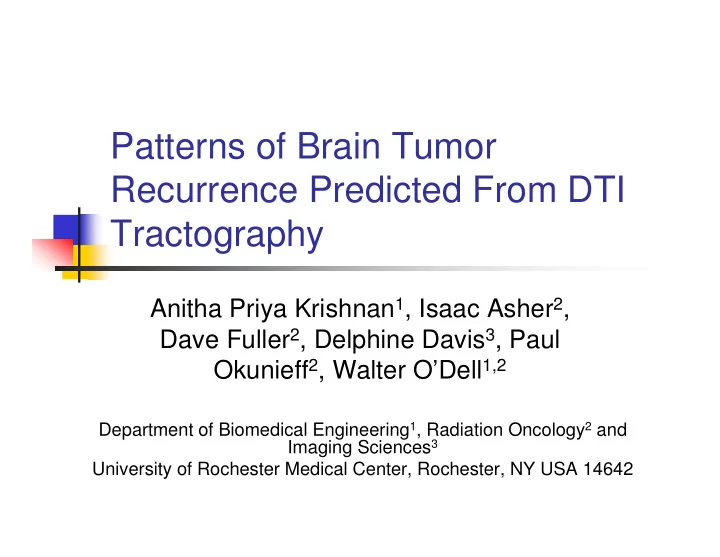

Patterns of Brain Tumor Recurrence Predicted From DTI Tractography Anitha Priya Krishnan 1 , Isaac Asher 2 , Dave Fuller 2 , Delphine Davis 3 , Paul Okunieff 2 , Walter O’Dell 1,2 Department of Biomedical Engineering 1 , Radiation Oncology 2 and Imaging Sciences 3 University of Rochester Medical Center, Rochester, NY USA 14642
Stereotactic Radiotherapy (SRT) � Radiation oncologists: 4 - 30mm isotropic margin for gliomas � Small margin: recurrences � Large margin: damage normal tissue � Clinical observation � Recurrence often at the boundary of treatment margin � Goal: � Develop appropriate anisotropic treatment margins using Diffusion Tensor Imaging (DTI)
Goal � Qualitative correlation of paths of elevated water diffusion along white matter tracts from Tractography with recurrent site. � Hypothesis: paths of elevated water diffusion along white matter tracts provide a preferred route for migration of cancer cells.
Migration Along WM Tracts � Migration of cancer cells along WM tracts in Glioblastoma: � 1938 Scherer HJ. � 1961 Matsukado et al. � 1988 Burger et al. � 1989 Johnson et al. � Correlate CT with topographic anatomy and postmortem MR imaging with neuropathologic findings � Our approach: Correlate White matter tracts from DTI of each patient with recurrent site
DTI of Glioblastoma � Scalars from DTI (Fractional Anisotropy and Apparent Diffusion Coefficient) � 2003 Price et al [1] � 2004 Hein et al [2] � 2005 Beppu et al [3] � Vectors from DTI (principal Eigen vector) � 2004 Field et al [4]
Patient Selection � Category1: distant recurrence � Small island of recurrent tumor in the DTI dataset acceptable � Category2: local recurrence � close to (within 2 cm) or on the boundary of the treatment plan � No sign of recurrence in the DTI dataset
Image Acquisition � GE signa 1.5T MRI scanner � EPI sequence, 20 axial slices, voxel dimensions 0.976 × 0.976 × 6 mm � 25 diffusion gradient directions, b = 1000, 3 reference (b = 0) scans
DTI Analysis � Tractography: DTIStudio and FSL ( ������� ������������������ � DTIStudio [5]: Fiber Assignment by Continuous Tracking (FACT)
DTI Analysis � FSL [6]: � Probabilistic fiber tracking � Calculates uncertainty in the fiber direction � Can track fibers in gray matter Fiber probability maps for seed point in optic tract Yellow – high probability, Red – moderate relative probability
Results: Category 1 (n = 3) Spot on left horn not Primary treated GBM Tumor Fiber growth tracts passing through: Primary tumor Recurrent site
Results: Category 1
Results: Category 2 (n = 4) Primary Glioma SRS treatment plan Pretreatment MR T1 Yellow – High probability. Red – Medium Recurrence tumor relative probability of connection Post contrast Axial MR T1 3 months after SRS Fiber Map from FSL
Results: Category 2 Primary tumor Pretreatment MR T1 SRS treatment plan Recurrence tumor Post contrast Axial MR T1 3 months after SRS Fibers from primary
Results: Category 2
Conclusions & Future Work � Preliminary results on a small number of patient datasets suggest that the hypothesis is correct � Future Work � High resolution DTI dataset using 3T MR � Improved Fiber analysis � Verification with animal models
References Price SJ, Burnet NG, Donovan T, et al. Diffusion tensor imaging of 1. brain tumors at 3T: a potential tool for assessing white matter tract invasion? Clin Radiol. 2003; 58: 455-462. Hein, Patrick A, Eskey, et al. Diffusion-Weighted Imaging in the 2. Follow-up of Treated High-Grade Gliomas: Tumor Recurrence versus Radiation Injury. AJNR Am J Neuroradiol 2004 25: 201-209. Beppu T, Inoue T, Shitaba Y, et al. Fractional anisotropy value by 3. diffusion tensor magnetic resonance imaging as a predictor of cell density and proliferation activity of glioblastomas. Surg Neurol. 2005; 63(1): 56-61. Field Aaron, Alexander Andrew. Diffusion Tensor Imaging in cerebral 4. tumor diagnosis and therapy. Top Magn Reson Imaging. 2004 oct; 15 (5): 315-24. Huang H, Zhang J, van Zijl PC, Mori S. Analysis of noise effects on 5. DTI-based tractography using the brute-force and multi-ROI approach. Magnetic Resonance in Medicine 2004;52(3):559-65. T.E.J. Behrens, M.W. Woolrich, et al. Characterisation and 6. Propagation of Uncertainty in Diffusion Weighted MR imaging. Magn. Reson Med 2003;50:1077-1088.
Recommend
More recommend